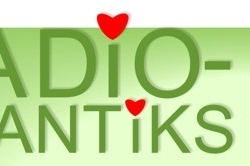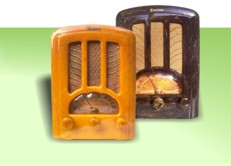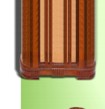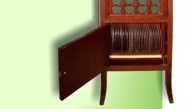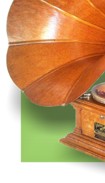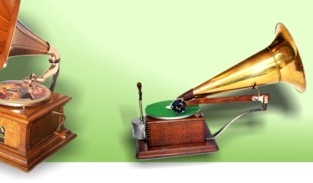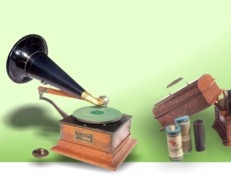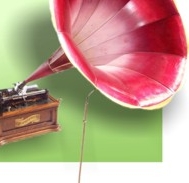|
Introduction:
The phonograph invented by Thomas Alva Edison [1847-1931] in 1877, in the beginning was used as a business dictation device and was rented for amusement in "phonograph parlors". In 1878 Edison made a top-ten list for the uses of his phonograph.
• 1. Letter writing, and all kinds of dictation without the aid of a stenographer.
• 2. Photographic books, which will speak to blind people without effort on their part.
• 3. The teaching of elocution.
• 4. Music-the phonograph will undoubtedly be liberally devoted to music.
• 5. .......
After inventing it, Edison lost interest and worked on his incandescent light bulb. In 1880 he started again by developing the Perfected Phonograph, and the 1889 Class M and Class E, all electrically powered machines. Edison rented them out for $40/year, again mainly to businesses and tried to sell them as dictation machines. It was Louis T. Glass and William S. Arnold, who in 1889 started to add coin-op mechanics to phonographs, and to make good money by installing "Nickel-in-the-Slot" machines in San Francisco restaurants, waiting rooms and arcades. The Columbia Graphophone Co., a subsidiary of the North American Phonograph Company, founded by Jesse H. Lippincott, in 1897 revolutionized the "Pay-to-Play" market by introducing their spring-motor coin-operated models BS and AS, both being small, cheap, reliable and easy-to-run machines.
Early machines had small horns, but the increasing density of coin-op phonographs made it necessary to install listening tubes, in order not to disturb other parlor patrons. Often a 13 inch tin horn was used; my machine came with an 11 inch japanned cone horn with a 6.5 inch opening, in my opinion the better match since it looks very similar to the original 10 inch Eagle B or Mignon Q horns. The horn has a lug, that very well could have been connected to a chain, that would have rendered the horn thief-proof, like the permanently attached crank, and even like the machine itself, that can be screwed to a stand. The heart of the phonograph is the simple and reliable Type B Eagle, designed by Thomas McDonald, complemented with the coin-slot and drop mechanics on the left side, and the automatic start/stop and reproducer up/down automatic on the right side.
The sound box is the famous floating reproducer #5 model D-1 with triple stepped mica diaphragms, that due to its large 2 inch diameter gives very good volume.
Additional information:
ref. 1. http://coin-o-phone.com/history.pdf
ref. 2. http://www.antiquephono.org/wp-content/uploads/documents/APS-201306-Fullssue.pdf
ref. 3. http://www.phonophan.com/graphophoneBS.html
ref. 4. http://www.radiomuseum.org/forum/jukebox_history_of_coin_operated_phonographs.html
ref. 5. https://en.wikipedia.org/wiki/Phonograph
ref. 6. https://youtu.be/kXOTXcYsIiU
About my coin-op:
The phonograph has its original finish. The original decal has some little wear, that however does not warrant replacement. The phonograph has been totally disassembled, cleaned, regreased and lubricated. Some metal parts were sanded by hand to remove some very mild corrosion. When reassembling the motor, a correct pretensioning of the spring barrels is important (see techies). The three glass windows are original too, exhibiting typical wavyness and including bubbles.
The three embossed sheet metal plaques are in mint condition.The only reproduction parts of this machine are the cabinet key and the sign board, that however is authentic, including the notorious "Graphaphone" spelling error. The lock is a very secure half mortise English lever tumbler lock, and the keys differ from machine to machine. I made mine by hand after having studied the opened lock. The most appropriate 2-minute cylinders to be played on this phonograph are "Indestructibles", introduced by several companies only at the production end of model BS in 1907. The two cylinders used in the video, two 1909 songs by then 36 years old contralto Ada Jones, "I've got Rings on my Finger" and "Beautiful Eyes" (watch youtube video by clicking on pict.38, or by going to ref.6) are included in the sale. Please e-mail me (Kris) for any questions, ich spreche Deutsch, je parle Français.
For the techies only:
A word about the operating principle of the mechanics: unlike the Edison coin-ops the Columbia sequence is - first the money and then wind-up. The weight of the correctly-sized nickel unlocks the wind-up gear. Each turn of the crank advances a 16-toothed wheel by one tooth, for a maximum of 13 turns. Cams on this wheel prevent more than 13 turns, but also require a minimum of 13 turns to start the motor. Other cams lower and rise the reproducer, drop the nickel into the coin box, and after playing the cylinder let the spring-loaded carriage snapping back to the left, where it is slowed down by a damping rubber ring. There are no reports about broken springs of this 2-spring motor, simply because it is impossible to overwind them. The tension reserve can be adjusted during assembly such, that there is always enough power left to play the end of a record with full speed.
|
Here are the specifications:
| Technical Description of Item |
| Manufacturer |
American Graphophone Co., New York |
| Distributor |
Columbia Phonograph Company, Chicago and others |
| Type |
BS, coin-operated |
| Production Year |
1897 |
| Serial Number |
188299 |
| Cabinet |
Oak |
| Controls |
Drop nickel, crank 13 turns |
| Reproducer |
Columbia floating reproducer #5 model D-1, 2" triple stepped mica diaphragm |
| Size (WxDxH) |
17" (incl. crank) x 10" x 13" (excl. horn) |
| Weight |
14½ lbs = 6.5 kg |
| Horn |
Black japanned cone horn, Eagle style, 11" x 6½", 11 oz. |
| Extras |
Two 1909 "Indestructible" 2-minute cylinders in box, sung by contralto Ada Jones |
| Comment |
Highly collectible early 2-minute cylinder phonograph |
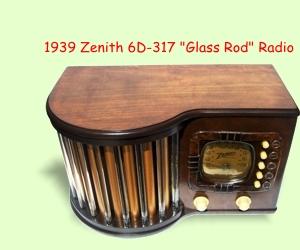 | |
Please have a look at prices and more radios, phonographs and gramophones here | |
 |
|


